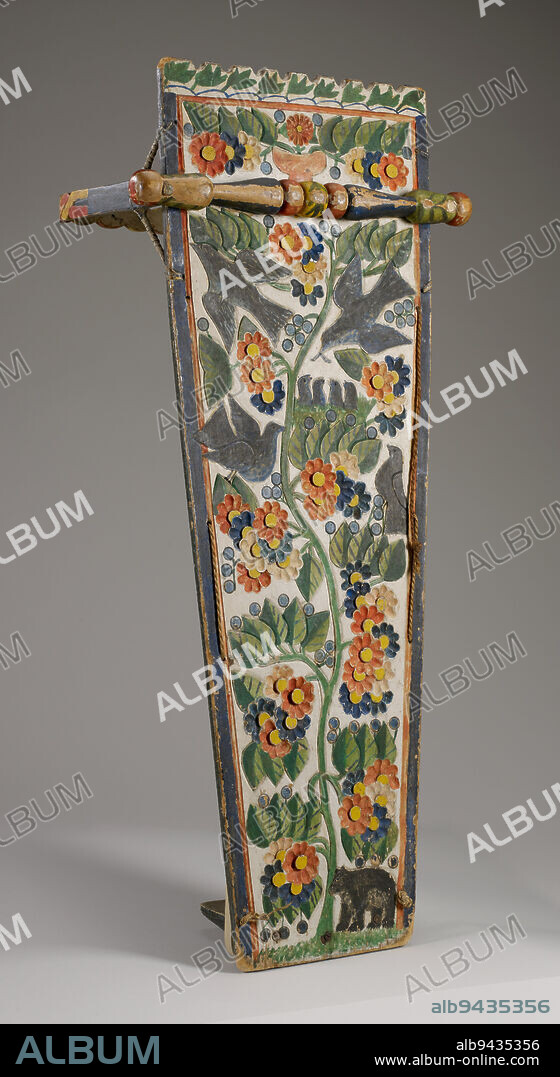alb9435356
Cradleboard, c.1850-1880, 32 1/4 x 13 1/4 x 14 1/4 in. (81.92 x 33.66 x 36.2 cm), Wood, pigment, string, United States, 19th century, The Kahnawake (Mohawk) of the Haudenosaunee (Iroquois Confederacy) create cradleboards from large planks of wood to which they attach protective bows that go over the child's head. Some examples have footrests to provide additional support. The backs are decorated with elaborate painted carvings. In the 17th century, the Kahnawake lived in an area surrounded by French-Canadian settlers, whose folk art influenced traditional Kahnawake art. Some scholars believe that the carving of some cradleboards was created by French-Canadian folk artists, but the iconography has a consistent theme related to the Kanien'gehaga traditional worldview. There is usually a carved flowering tree that may reference the Sky World; the tree often has a mother bird feeding her young and represents the relationship between the cosmos and the Kahnawake people.

|
Ajouter à une autre Lightbox |
|
Ajouter à une autre Lightbox |



Avez-vous déjà un compte? S'identifier
Vous n'avez pas de compte ? S'inscrire
Acheter cette image

Légende:
Voir la traduction automatique
Cradleboard, c.1850-1880, 32 1/4 x 13 1/4 x 14 1/4 in. (81.92 x 33.66 x 36.2 cm), Wood, pigment, string, United States, 19th century, The Kahnawake (Mohawk) of the Haudenosaunee (Iroquois Confederacy) create cradleboards from large planks of wood to which they attach protective bows that go over the child's head. Some examples have footrests to provide additional support. The backs are decorated with elaborate painted carvings. In the 17th century, the Kahnawake lived in an area surrounded by French-Canadian settlers, whose folk art influenced traditional Kahnawake art. Some scholars believe that the carving of some cradleboards was created by French-Canadian folk artists, but the iconography has a consistent theme related to the Kanien'gehaga traditional worldview. There is usually a carved flowering tree that may reference the Sky World; the tree often has a mother bird feeding her young and represents the relationship between the cosmos and the Kahnawake people.
Crédit:
Album / quintlox
Autorisations:
Modèle: Non - Propriété: Non
Questions sur les droits?
Questions sur les droits?
Taille de l'image:
3655 x 6685 px | 69.9 MB
Taille d'impression:
30.9 x 56.6 cm | 12.2 x 22.3 in (300 dpi)
Mots clés:
17E SIECLE • 17EME S • ADOLESCENT • AMERICAIN (ETATS-UNIS) • AMERICAIN (USA) • ARBRE • ARBRES • COSMOS • DIX-SEPTIÈME SIÈCLE • ÉTAS UNIS • ÉTAS-UNIS • ETATS UNIS • ETATS-UNIS • ICONOGRAPHIE • JEUNE • PIGMENT • U. S. A. • XIXE SIÈCLE • XVIIE SIECLE • ŽTATS-UNIS
 Pinterest
Pinterest Twitter
Twitter Facebook
Facebook Copier le lien
Copier le lien Email
Email
